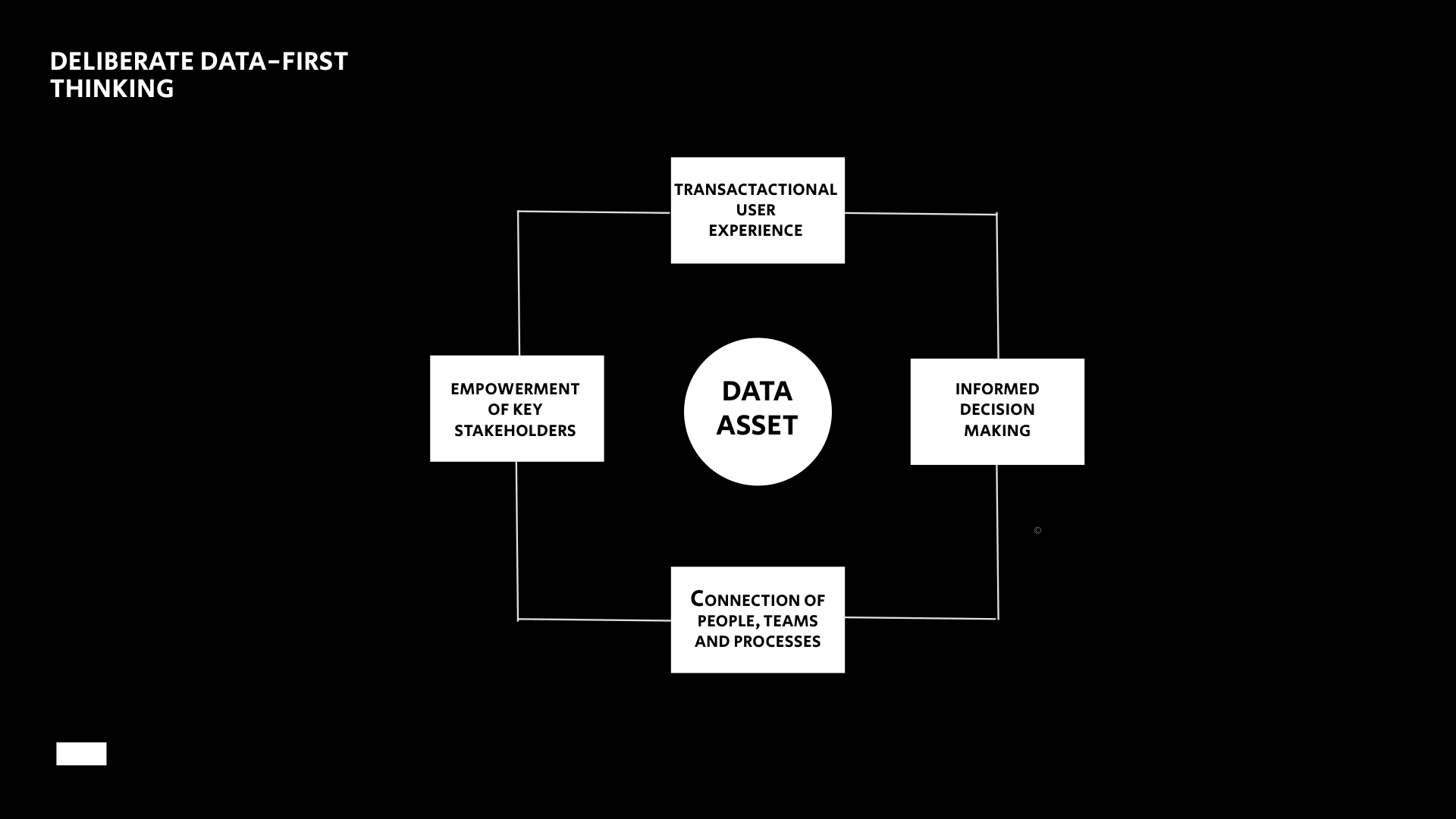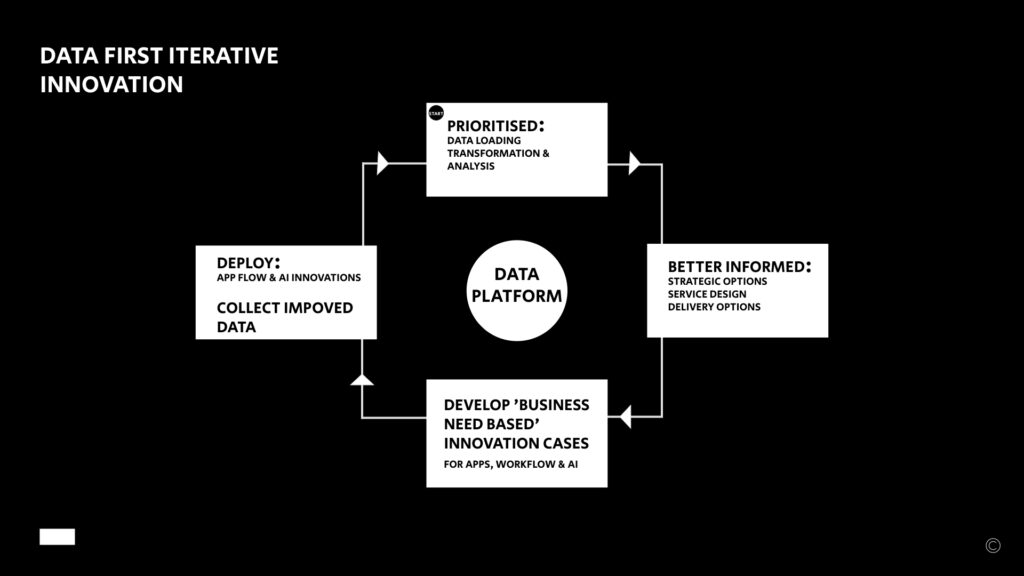
being deliberate with data
blog No 2 in the
data-first thinking Series
In my first Blog in this series, I introduced Pivotl’s evolving Data-First Methodology to help complex organisations achieve better outcomes through data, focusing on two key principles that underpin Data-First:
- Being Deliberate with Data and
- Approaching Data Foundationally
Here’s more detail about being ‘Deliberate with Data’:
In essence it’s all about shifting from a passive to a deliberate data mindset. Moving from passively collecting data, with little consideration of its value beyond the immediate activity in which it is being gathered, to being precise about what data should enable or achieve within a specific organisation.
At a strategic level this means the value of an organisation’s ‘Data Strategy’ is determined by how it demonstrates the specific business critical improvements the strategy will enable.
Answering the following questions is a must:
- What should our data do for our particular business? or more precisely
- What business activities can we improve through a better use of data?
- What specific business outcomes would these improvements enable for our organisation?
The Data-First organisation determines the insight it really needs, rather than rehashing what it already has.
To help structure this type of thinking, Pivotl believes data investment aligns effectively to four key areas of organisational improvement:

The diagram shows all four areas of improvement are related to an organisation’s data asset.
Not all data is part of an organisation’s data asset, only the data that adds value. This value adding data requires ongoing deliberate investment to maintain or increase its value to the organisation; ultimately enabling the organisation’s outcomes.
By identifying and prioritising specific improvement projects/outputs under each heading, the organisation can establish greater control over the development of its data asset.
Achieving this level of understanding of insight requirements can be done in weeks, not months and the benefits will last for years.
Improving transactional user experience through Data
Data is collected through every transaction an organisation undertakes; however this data often remains siloed in legacy solutions aligned to organisational departments, not customer or user journeys.
Organisation’s working from a Data-First perspective deliberately design the availability of data to fit the customer journey. Knowing where specific information should be available across a customer journey, and they invest to enable information to be presented accordingly. Examples include:
- Automatic partial form completion or pop-up screens of relevant additional services based on a customer’s previous transactions.
- Automated tracking or push alerts in longer or multi agent transactions
- Sharing location image data to mobile workers with work orders, enabling them to judge appropriate access times, conditions and equipment etc.
Every known case for data improving specific transactions should be captured, qualified, themed and prioritised to develop a specific and meaningful data strategy.
Every known case for data improving specific transactions should be captured, qualified, themed and prioritised to develop a specific and meaningful data strategy.
Improving informed decision making through Data
Insight and analytics form part of every data strategy; analysing data to make better decisions. However, what’s often missing is engagement with the business to deliberately determine:
- What opportunities are they trying to realise through better insight-based decisions?
- What challenges will better insight help them overcome?
Having thematic outcomes based discussions is the best way to overcome the risk of just serving up the same level of insight in a new format or technology. The Data-First organisation determines the insight it really needs, rather than rehashing what it already has.
Only when all identifiable insight requirements are understood, themed and prioritised can an organisation optimise efficient investment. Investment to bring the right data together, combine it with the right tools and capability to develop descriptive, diagnostic, predictive and prescriptive insight.
My personal experience is achieving this level of understanding of insight requirements can be done in weeks, not months and the benefits will last for years.
Improving the connection of people, teams and processes
Data flow is an increasing priority for CIOs, CDOs and COOs and their teams. Connecting organisations internally and externally through data. The more complex the organisational value chain, the more important data flow is. Organisations working in multi-agency or commissioning / delivery models must move data this multi-faceted delivery network securely, right time, right format to the right individual or team.
Ever increasing data flow capability is being built into all cloud data services and associated tools. However, deploying mobile apps, connectors, workflow tools etc. should be preceeded by establishing precisely why improving the flow of data through a series of processes and teams benefits the organisation. Where are we creating duplication, delay, inventory, false analysis, failure demand through poorly flowing data?
The best solution for establishing ‘the why improve data flow’ lies in better insight. By using data to build visual insight, organisations can identify where all the symptoms of poor data flow are. This then provides the evidence base for investing in data flow technologies.
Improvement can then also be measured using these insights and the improved quality of data in turn improves the insight that can be delivered.

By using data to build visual insight, organisations can identify where all the symptoms of poor data flow are.
Improving the empowerment of customer, workers and other key stakeholders
AI is exciting, it’s also potentially daunting. There are ethical and legal considerations surrounding the use of AI. At Pivotl we believe AI should be looked as something to empower people, rather than replace them.
AI / cognitive technologies have great immediate potential to help workers, customers and other stakeholders see issues, risks, challenges and opportunities. The ability of generative AI to open up technology configuration to people from a non-technology background is the core benefit of Microsoft CoPilot. This will enable an even greater democratisation of data as people who are great subject experts but not technical experts can effectively analyse data, create data flows, configure AI solutions to meet the needs they can expertly identify.
Generative AI can supplement existing levels of knowledge and practice with best practice from around the world. At Pivotl we are developing Generative AI solutions to support enterprise data management and data quality checks across complex data sets.
Identifying opportunities for traditional AI should follow the same supplementary mindset. People working in the business, know where capacity and capability is needed. There is an inevitable data-lag for traditional AI, as there is for Machine Learning analytic tools. Many organisations don’t have enough data of the right quality to deliver the benefit of traditional AI. However, by recognising where AI can make a difference, the organisation can get on a deliberate pathway of evolving its data quality to support the potential of this exponentially improving technology.
In the next blog in this series I will move from establishing the why and the what of becoming a Data-First organisation to the how. This will lay out four key foundation blocks which these four areas of organisational improvement can be enabled.
But in the meantime, please get in touch if you want to discuss this in more detail.





